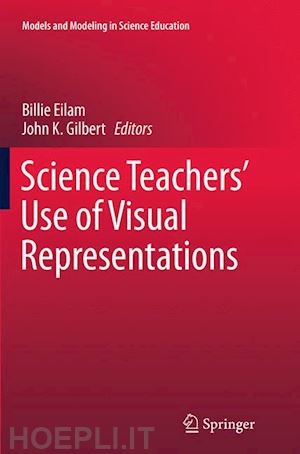
Questo prodotto usufruisce delle SPEDIZIONI GRATIS
selezionando l'opzione Corriere Veloce in fase di ordine.
Pagabile anche con Carta della cultura giovani e del merito, 18App Bonus Cultura e Carta del Docente
This book examines the diverse use of visual representations by teachers in the science classroom. It contains unique pedagogies related to the use of visualization, presents original curriculum materials as well as explores future possibilities.
The book begins by looking at the significance of visual representations in the teaching of science. It then goes on to detail two recent innovations in the field: simulations and slowmation, a process of explicit visualization. It also evaluates the way teachers have used different diagrams to illustrate concepts in biology and chemistry.
Next, the book explores the use of visual representations in culturally diverse classrooms, including the implication of culture for teachers’ use of representations, the crucial importance of language in the design and use of visualizations and visualizations in popular books about chemistry. It also shows the place of visualizations in the growing use of informal, self-directed science education.
Overall, the book concludes that if the potential of visualizations in science education is to be realized in the future, the subject must be included in both pre-service and in-service teacher education. It explores ways to develop science teachers’ representational competence and details the impact that this will have on their teaching.
The worldwide trend towards providing science education for all, coupled with the increased availability of color printing, access to personal computers and projection facilities, has lead to a more extensive and diverse use of visual representations in the classroom. This book offers unique insights into the relationship between visual representations and science education, making it an ideal resource for educators as well as researchers in science education, visualization and pedagogy.
Section A: Research into teaching with visual representations.- Introduction.- Chapter 1 : The significance of visual representations in the teaching of science, B. Eilam, J.K. Gilbert.- Chapter 2 : Teaching and researching visual representations: Shared vision or divided world? S. Ainsworth & L. Newton.- Section B: Teachers’ selections, constructions and use of visual representations.- Introduction.- Chapter 3 : Representing visually: What teachers know and what they prefer, B. Eilam, Y. Poyas, R. Hasimshoni.- Chapter 4 : Slowmation: A process of explicit visualisation, J. Loughran.- Chapter 5 : Secondary biology teachers’ use of different types of diagrams for different purposes, Y. Liu, M. Won, D.F. Treagust.- Chapter 6 : Teaching stoichiometry with particulate diagrams – linking macro phenomena and chemical equations, M.W. Cheng, J.K. Gilbert.- Section C: Teachers’ use of visual representations in culturally-diverse classrooms.- Introduction.- Chapter 7 : Thoughts on visualizations in diverse cultural settings: The case of France and Pakistan, E. De Vries, M. Ashraf.- Chapter 8 : The implication of culture for teachers’ use of representations, B. Waldrip, S. Satupo, F. Rodie.- Chapter 9 : The interplay between language and visualization: The role of the teacher, L. Mammino.- Chapter 10: Visualizations in popular books about chemistry, J.K. Gilbert, A. Afonso.- Section D: Teachers’ supporting student learning from visual representations.- Introduction.- Chapter 11 : Teachers using interactive simulations to scaffold inquiry instruction in physical science education, D. Geelan, X.Fan.- Chapter 12: Transformed instruction: Teaching in a student-generated representations learning environment, O. Parnafes, R. Trachtenberg-Maslaton.- Chapter 13: The laboratory for making things: Developing multiple representations of knowledge, J. Bamberger.- Section E: Overview.- Chapter 14: Developing science teachers’ representational competence and itsimpact on their teaching, J.K.Gilbert, B. Eilam.











Il sito utilizza cookie ed altri strumenti di tracciamento che raccolgono informazioni dal dispositivo dell’utente. Oltre ai cookie tecnici ed analitici aggregati, strettamente necessari per il funzionamento di questo sito web, previo consenso dell’utente possono essere installati cookie di profilazione e marketing e cookie dei social media. Cliccando su “Accetto tutti i cookie” saranno attivate tutte le categorie di cookie. Per accettare solo deterninate categorie di cookie, cliccare invece su “Impostazioni cookie”. Chiudendo il banner o continuando a navigare saranno installati solo cookie tecnici. Per maggiori dettagli, consultare la Cookie Policy.